We Use CookiesWe use cookies to enhance the security, performance,
functionality and for analytical and promotional activities. By continuing to browse this site you
are agreeing to our privacy policy
10 Best Pool Robots
From leading brands and best sellers available on the web.By clicking on a link to a third party's website, log data is shared with that third party.
Buying Guide for the Best Pool Robots
Choosing a pool robot can make pool maintenance a breeze, saving you time and effort while keeping your pool crystal clear. Since there are many different options with various features, it's important to understand the main specifications and how they relate to your needs. Start by thinking about your pool's size, shape, and the kinds of debris you usually see. By matching these factors with the right specs, you can find a pool robot that efficiently and reliably keeps your pool in top condition.Pool Compatibility (Type and Size)Pool robots are designed for different pool types (in-ground or above-ground) and sizes. This is important because not all robots can handle very large pools or may be too powerful for small, above-ground setups. Pool size compatibility is usually listed in terms of maximum pool length or area in square feet or meters. For small pools, compact models with less powerful motors will suffice, while bigger pools require robots with longer cable lengths and better coverage capabilities. Always pick a robot rated for at least the size and type of your pool to ensure full cleaning coverage.
Cleaning Coverage (Floor, Walls, Waterline)This refers to which parts of your pool the robot can clean. Some basic models only clean the floor, while more advanced ones can scrub walls and even the waterline. Floor-only units are fine if debris settles mainly at the bottom or if your walls are mostly clean. For pools that accumulate dirt, algae, or scum on the walls and waterline, choose a robot that specifies wall-climbing and waterline scrubbing. Assess your pool's problem areas to decide the level of coverage needed.
Filtration SystemThe filtration system describes how the robot captures debris and what size particles it can filter out. Finer filters trap pollen, sand, and dust, while coarser filters focus on leaves and larger debris. Some models offer changeable or dual filters to handle both fine and large debris. If your pool is surrounded by trees or gets big debris, opt for a robot with a large filter basket or multiple filtration options. For users more concerned with dust and small particles, prioritize models known for fine filtration.
Power Source (Corded vs. Cordless)Some robots plug into mains power via a long cord, while cordless robots use rechargeable batteries. Corded robots are generally more powerful and suited to long or frequent cleaning sessions, but the cord limits range and can tangle. Cordless models are easier to handle and great for smaller pools or occasional use, though they need to be charged and may run for shorter periods. Think about convenience and whether your pool's setup allows for safe cord use when deciding between these options.
Navigation and Smart FeaturesPool robots use different navigation systems to move around—some follow random patterns, while others use sensors or mapping algorithms for more efficient coverage. Advanced robots with smart navigation clean more quickly and avoid missing spots or getting stuck. Some include programmable schedules, remote controls, or smartphone connectivity. If you value 'set it and forget it' convenience, look for robots with smart mapping, scheduling, and remote operation. For occasional manual operation, simpler navigation might suffice.
Cycle Time and Cleaning SpeedCycle time is how long the robot takes to complete a cleaning session. Faster robots can finish quickly, while slower ones might be more thorough. Some allow you to set longer or shorter cycles based on your cleaning needs. Consider how frequently you want to clean the pool and how quickly you want the job done. For busy schedules or frequent use, a robot with customizable or shorter cycles might be ideal, while those who clean less often may prefer a thorough, longer session.
Ease of Use and MaintenanceThis relates to how simple it is to operate and maintain your robot, especially when it comes to emptying the filter and managing the device. Features like top-access filter baskets, lightweight design, or quick drain systems make maintenance much easier. If you want a hassle-free experience, look for robots advertised as easy to clean and handle. Consider how often you'll need to maintain your robot and choose accordingly if you prefer spending less time on upkeep.
















